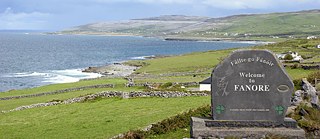Traces along the Wild Atlantic Way
Francis Stuart, writer and controversial Saoi

He was elected a Saoi, the highest honour given by Ireland to an artist, yet the controversy surrounding his links with Nazi Germany never went away.
Born in Australia in 1902, Francis Stuart came to Ireland at the age of 1. At age 18 he married Iseult Gonne, daughter of the Irish revolutionary Maud Gonne. They lived in Laragh, County Wicklow, where Stuart pursued his literary ambitions. Through Iseult’s brother, Sean McBride, he became involved with the Irish Republican Army (IRA). During a lecturing and reading tour in Germany in 1939 he was offered a lectureship in Berlin; before he took up the post, he met with the IRA to discuss contacts with the German authorities, and acted as an intermediary.
In Berlin, he became involved in plotting the mission of the most notorious German spy in Ireland, Hermann Görtz. He also began to write radio scripts for William Joyce, ‘Lord Haw-Haw’, who broadcast English-language propaganda for the Nazis. When the war ended, Stuart and a former student, Gertrude Meissner, were interned for a short time. They married in 1954, after Iseult’s death. Stuart’s experiences in Germany are reflected in The Pillar of Cloud (1948). The couple moved to Ireland in 1958. In 1996 Stuart was elected a Saoi by Aosdána, the affiliation of Irish artists honoured by the State.
The title of Saoi (Wise One) is the highest accolade Ireland can give to an artist, and there are no more than seven Saoithe at any one time. Stuart’s elevation to this position was highly controversial; many people objected to it on account of his links with Nazi Germany. Francis Stuart died in 2000, at almost 98, and is buried in Fanore, County Clare. His literary legacy includes 16 novels, two poetry collections and a collection of prose writings.
Visitor Information:
Fanore Cemetery
Craggagh Fanore
Co. Clare Ireland
„German Traces in Ireland“ is a project of the Goethe-Institut Irland.